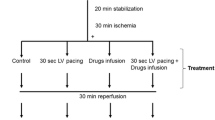Abstract
ATP depletion is always associated with prolonged ischemia. It was found that ATP affected calcium- and phospholipid-dependent activation of protein kinase C without hydrolysis of the nucleotide when the activation was monitored by an assay for [3H] 4-β-phorbol-12, 13-dibutyrate binding activity in a reconstitution system having physiological concentrations of free calcium. When the ATP level was low, an increase in the free calcium concentration could not activate the enzyme. A decrease in pH exacerbated the depressed activation. The concentration of magnesium also affected the activation. On the other hand, free fatty acids, which increase during ischemia, were able to activate the enzyme at a low concentration of ATP in the absence of phorbol ester and phosphatidylserine. These results suggest that calcium- and phospholipid-dependent activation of protein kinase C is suppressed during ischemia, and that fatty acids in turn activate the enzyme. It is possible that ischemia interferes with normal signal transduction via the protein kinase C pathway and causes unusual protein phosphrylation.
Similar content being viewed by others
References
Raichle ME: The pathophysiology of brain ischemia. Ann Neurol 13:2–10, 1983
Nishizuka Y: The molecular heterogeneity of protein kinase C and its implications for cellular regulation. Nature 334:661–665, 1988
Baraban JM: Phorbol esters: Probes of protein kinase C function in the brain. Trends Neuro Sci 10:57–58, 1987
Ganong BR, Loomis CR, Hannun YA, Bell RM: Specificity and mechanism of protein kinase C activation bysn-1, 2-diacylglycerols. Proc Natl Acad Sci USA 83:1184–1188, 1986
Sekiguchi K, Tsukada M, Ogita K, Kikkawa U, Nishizuka Y: Three distinct forms of rat brain protein kinase C: Differential response to unsaturated fatty acids. Biochem Biophys Res Commun 145:797–802, 1987
Kikkawa U, Takai Y, Minakuchi R, Inohara S, Nishizuka Y: Calcium-activated, phospholipid-dependent protein kinase from rat brain: Subcellular distribution, purification, and properties. J Biol Chern 257:13341–13348, 1982
Irita K, Cuatrecasas P, Hebdon GM: Regulation of protein kinase C by ATP concentration. submitted.
Kobayashi M, Lust WD, Passonneau JV: Concentrations of energy metabolites and cyclic nucleotides during and after bilateral ischemia in the gerbil cerebral cortex. J Neurochem 29:53–59, 1977
Irita K, Cuatrecasas P, Hebdon GM: Fatty acid substitution for phosphatidylserine in a reconstitution of phorbol binding to protein kinase C from rat brain: Dissociation of phorbol binding from the activation of protein kinase C. submitted.
Nakagawara M, Takeshige K, Takamatsu J, Takahashi S, Yoshitake J, Minakami S: Inhibition of superoxide production and Ca2+ mobilization in human neutrophils by halothane, enflurane, and isoflurane. Anesthesiology 64:4–12, 1986
Cheung JY, Bonventre JV, Malis CD, Leaf A: Calcium and ischemic injury. N Eng J Med 314:1670–1676, 1986
Uematsu D, Greenberg JH, Reivich M, Kobayashi S, Karp A: In vivo fluorometric measurement of changes in cytosolic free calcium from the cat cortex during anoxia. J Cereb Blood Flow Metab 8:367–374, 1988
Chopp M, Frinak S, Walton DR, Smith MB, Welch KMA: Intracellular acidosis during and after cerebral ischemia:In vivo nuclear magnetic resonance study of hyperglycemia in cats. Stroke 18:919–923, 1987
Rehncrona S, Westerberg E, Akesson B, Siesjö BK: Brain cortical fatty acids and phospholipids during and following complete and severe incomplete ischemia. J Neurochem 38:84–93, 1892
Vink R, McIntosh TK, Demediuk P, Weiner MW, Faden AI: Decline in intracellular free Mg2+ is associated with irreversible tissue injury after brain trauma. J Biol Chem 263:757–761, 1988
Turner RS, Raynor RL, Mazzei GJ, Girard PR, Kuo JF: Developmental studies of phospholipid-sensitive Ca2+-dependent protein kinase and its substrate and of phosphoprotein phosphatases in rat brain. Proc Nat! Acad Sci USA 81:3143–3147, 1984
Matthys E, Patel Y, Kreisberg J, Stewart JH, Venkatachalam M: Lipid alterations induced by renal ischemia: Pathogenic factor in membrane damage. Kidney Int 26:153–161, 1984
Hochachka PW: Defense strategies against hypoxia and hypothermia. Science 231:234–241, 1986
Vaccarino F, Guidotti A, Costa E: Ganglioside inhibition of glutamate-mediated protein kinase C translocation in primary cultures of cerebellar neurons. Proc Natl Acad Sci 84:8708–8711, 1987
Wightman PD, Raetz CRR: The activation of protein kinase C by biologically active lipid moieties of lipopolysaccharide. J Biol Chem 259:10048–10052, 1984
Spitzer JA, Turco ER, Deaciuc IV, Roth BL: Perturbation of transmembrane signaling mechanisms in acute and chronic endotoxemia. Prog Clin BioI Res 236A:401–418, 1987
Chin JH, Buchholz TM, DeLorenzo RJ: Calmodulin and protein phosphorylation: Implications in brain ischemia. Prog Brain Res 63:169–184, 1985
Chaudry IH, Baue AE: Depletion and replenishment of cellular cyclic adenosine monophosphate in hemorrahgic shock. Surg Gynecol Obstet 145:877–881, 1977
Author information
Authors and Affiliations
About this article
Cite this article
Irita, K., Hebdon, M.G., Cuatrecasas, P. et al. Protein kinase C and simulated ischemia possible aberrations of signal transduction during ischemia. J Anesth 3, 172–177 (1989). https://doi.org/10.1007/s0054090030172
Received:
Accepted:
Published:
Issue Date:
DOI: https://doi.org/10.1007/s0054090030172




